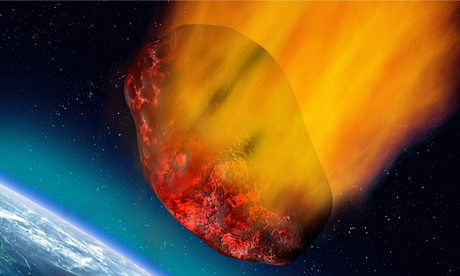Asteroid 2000 EM26: 'potentially hazardous' space rock to fly close to Earth
Space rock to pass by Earth 2.1m miles away, but astronomers say 270-metre object poses significant danger in case of impact

Asteroid 2000 EM26 is
due to fly past Earth at 2am UK time roughly 2.1m miles away, but its
large size means it is classified as potentially hazardous. Photograph:
Paul Fleet/Alamy
.
A "potentially hazardous" asteroid the size of three football fields will come uncomfortably close to Earth early on Tuesday.
The space rock, known as 2000 EM26, poses no threat and will pass the Earth at just under nine times the distance to the moon.
.
But it is defined as a potentially hazardous near-Earth object (NEO) large enough to cause significant damage in the event of an impact. Scientists estimate the asteroid, travelling at 27,000mph, is 270 metres (885ft) wide.
At its closest approach at 2am UK time, the rock will be 2.1m miles from Earth, or 8.8 lunar distances.
.
Images of the asteroid making its flyby will be captured by the Slooh robotic telescope service, which provides internet access to automated observatories.
2000 EM26 makes its appearance almost exactly a year after two major NEO events on 15 February 2013.
.
As scientists tracked a 30-metre wide asteroid that brushed by the Earth at a distance of 17,200 miles, another space rock unexpectedly exploded above Chelyabinsk, Russia.
The meteor, thought to measure 20 metres wide, released the energy of 20 atomic bombs 18 miles above the ground.
Thousands of buildings were damaged and many people injured by flying glass and debris, but no one was killed.
.
Slooh astronomer Dr Bob Berman said: "On a practical level, a previously unknown, undiscovered asteroid seems to hit our planet and cause damage or injury once a century or so, as we witnessed on 20 June 1908 and 15 February 2013.
.
"Every few centuries, an even more massive asteroid strikes us – fortunately usually impacting in an ocean or wasteland such an Antarctica. But the ongoing threat, and the fact that biosphere-altering events remain a real if small annual possibility, suggests that discovering and tracking all NEOs, as well as setting up contingency plans for deflecting them on short notice should the need arise, would be a wise use of resources."
The space rock, known as 2000 EM26, poses no threat and will pass the Earth at just under nine times the distance to the moon.
.
But it is defined as a potentially hazardous near-Earth object (NEO) large enough to cause significant damage in the event of an impact. Scientists estimate the asteroid, travelling at 27,000mph, is 270 metres (885ft) wide.
At its closest approach at 2am UK time, the rock will be 2.1m miles from Earth, or 8.8 lunar distances.
.
Images of the asteroid making its flyby will be captured by the Slooh robotic telescope service, which provides internet access to automated observatories.
2000 EM26 makes its appearance almost exactly a year after two major NEO events on 15 February 2013.
.
As scientists tracked a 30-metre wide asteroid that brushed by the Earth at a distance of 17,200 miles, another space rock unexpectedly exploded above Chelyabinsk, Russia.
The meteor, thought to measure 20 metres wide, released the energy of 20 atomic bombs 18 miles above the ground.
Thousands of buildings were damaged and many people injured by flying glass and debris, but no one was killed.
.
Slooh astronomer Dr Bob Berman said: "On a practical level, a previously unknown, undiscovered asteroid seems to hit our planet and cause damage or injury once a century or so, as we witnessed on 20 June 1908 and 15 February 2013.
.
"Every few centuries, an even more massive asteroid strikes us – fortunately usually impacting in an ocean or wasteland such an Antarctica. But the ongoing threat, and the fact that biosphere-altering events remain a real if small annual possibility, suggests that discovering and tracking all NEOs, as well as setting up contingency plans for deflecting them on short notice should the need arise, would be a wise use of resources."

No comments:
Post a Comment